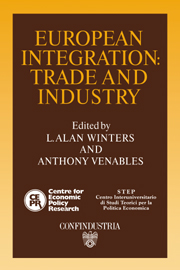Book contents
- Frontmatter
- Contents
- List of figures
- List of tables
- Preface
- Acknowledgements
- List of conference participants
- 1 European integration: trade and industry
- 2 Completing the internal market in the EC: factor demands and comparative advantage
- Discussion
- 3 External effects and Europe's integration
- Discussion
- 4 The quality and production of textiles and clothing and the completion of the internal market
- Discussion
- 5 Competition and imports in the European market
- Discussion
- 6 The structure and determinants of East–West trade: a preliminary analysis of the manufacturing sector
- Discussion
- 7 1992 and EFTA
- Discussion
- 8 Technology policy in the completed European market
- Discussion
- 9 Corporation tax, foreign direct investment and the single market
- Discussion
- 10 Japanese direct manufacturing investment in Europe
- Discussion
- Index
3 - External effects and Europe's integration
Published online by Cambridge University Press: 07 September 2010
- Frontmatter
- Contents
- List of figures
- List of tables
- Preface
- Acknowledgements
- List of conference participants
- 1 European integration: trade and industry
- 2 Completing the internal market in the EC: factor demands and comparative advantage
- Discussion
- 3 External effects and Europe's integration
- Discussion
- 4 The quality and production of textiles and clothing and the completion of the internal market
- Discussion
- 5 Competition and imports in the European market
- Discussion
- 6 The structure and determinants of East–West trade: a preliminary analysis of the manufacturing sector
- Discussion
- 7 1992 and EFTA
- Discussion
- 8 Technology policy in the completed European market
- Discussion
- 9 Corporation tax, foreign direct investment and the single market
- Discussion
- 10 Japanese direct manufacturing investment in Europe
- Discussion
- Index
Summary
Introduction
The objective of this study is to bring greater relevance vis-à-vis the issue of European economic integration to our previous work on external economies (Caballero and Lyons, 1989, 1990a, 1990b, hereafter C & L). There we find strong evidence of external economies in both the United States and Europe. The type of external effect we pick up in those studies is a country-specific, inter-industry external effect: an industry is able to generate more real output for given level of inputs when other industries within that country are at higher production levels. Yet external effects come in a number of different varieties, the most popular in the international trade literature being intra-industry effects, and here we consider at greater depth whether there is any clear evidence on the presence of the latter. The European context is particularly appealing for such an investigation, given both the high degree of current integration of these economies and the further integration to come, and the issue is potentially even more important in properly evaluating the gains from 1992. To the extent that positive external effects are at work internationally, this channel could be expected to contribute to the ‘energising’ of Europe.
To set the stage for the evidence we present, it is helpful first to consider some of the theoretical work on external economies, which is both quite extensive and spans a number of different areas.
- Type
- Chapter
- Information
- European IntegrationTrade and Industry, pp. 34 - 51Publisher: Cambridge University PressPrint publication year: 1991
- 2
- Cited by



